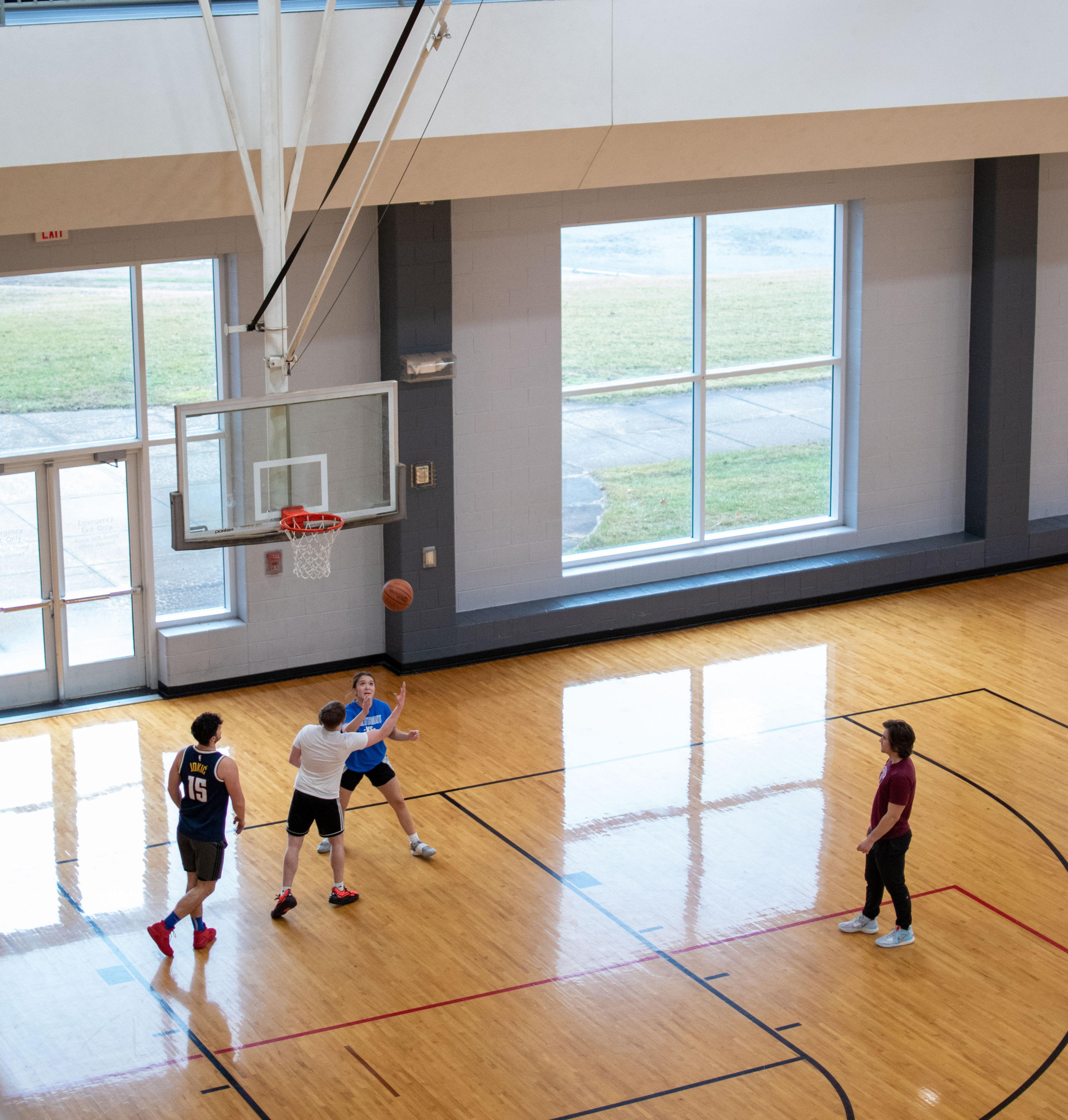
EAT FRESH A local guide to restaurants with healthy eats PAGE 4 EFFECT OF MUSIC How college students use music as stress-management PAGE 12 GET MOVING! OU Rec Center events and programs to stay busy this semester PAGE 8-9
Oakland University’s Independent Student Newspaper Rochester, Michigan Volume 48 l Issue 15 l January 11, 2023 THE POSTOakland A kick-start to 2023 SPECIAL EDITION: Health and Wellness
PHOTO BY LINDSEY SOBKOWSKI
Olivia Chiappelli
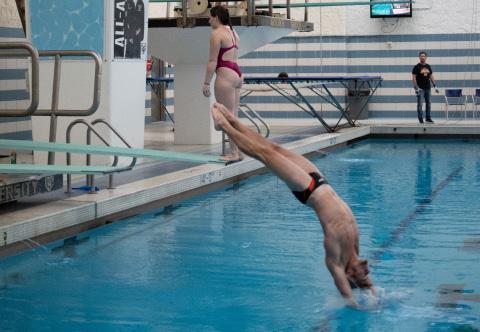
Autumn Okuszka
EDITORIAL BOARD
Gabrielle Abdelmessih Editor-in-Chief gabdelmessih@oakland.edu
Tori Coker Content Editor toricoker@oakland.edu
Megan Parker Managing Editor meganparker@oakland.edu
EDITORS
Lindsey Sobkowski Photo Editor lsobkowski@oakland.edu
Brock Heilig Sports Editor brockheilig@oakland.edu
Arianna Heyman Features Editor aheyman@oakland.edu
Joe Zerilli Campus Editor jzerilli@oakland.edu
Bella Javier Arts Editor isabellajavier@oakland.edu
DISTRIBUTION
Sam Poudal Distribution Director spoudal@oakland.edu
Melanie Davis Distributor
ADVISING
Garry Gilbert Editorial Adviser gjgilber@oakland.edu 248.370.2105
Don Ritenburgh Business Adviser ritenbur@oakland.edu 248.370.2533

THIS WEEK
CORRECTIONS CORNER: The Oakland Post corrects all known errors of fact. If you know of an error, please email editor@oaklandpostonline.com.
Wood Graphic Designer
Iatrou Graphic Designer
Walters Graphic Designer
Udeozor-Nweke Graphic Designer
Jennifer
Emily
Melissa
Christopher
REPORTERS
Reporter
Reporter
Payton Bucki
DJ Lester
Reporter
Reporter
Reporter
Summer Weathers
CONNECT ONLINE AT:
oaklandpostonline.com DIVE IN! Golden A splashy start to 2023.
BY LINDSEY SOBKOWSKI 2 | JANUARY 11, 2023
OF THE WEEK
PHOTO
PHOTO
COPY & VISUAL
Santos Marketing Director
Leticia Cezário
lsantos@oakland.edu
Letter from the editor: A kickstart to 2023


GABRIELLE ABDELMESSIH
Editor-in-Chief
Welcome to the first issue of 2023!
To kickstart 2023, The Post decided to make this issue a “special edition” delving into all things health and wellness.
The purpose of this issue is to be informational, motivational and self-reflective.
I’d like to thank all of my fellow Posties for their hard work on this issue. Thanks for reading! We appreciate your continued support.
“It is a privilege to do the work,” my energetic pilates instructor said, attempting to motivate a class of about 20 people to the muscle failure point of no return.
I have to admit, at 6:20 a.m. while holding my right leg in a bungee cord high up the air, glutes burning, sweat pouring (sorry…tmi?), privilege certainly wasn’t the first word that came to mind to describe the experience, but the instructor’s words resonated with me.
Because that’s exactly what taking fifty minutes out of my day, money out of my wallet, and expending energy to focus on me and my health is — a privilege.
Extrapolating her motivational train of thought brought me to the natural conclusion that it truly is a privilege to be healthy enough to exercise, wealthy enough to afford it in that setting and wise enough to invest in my future health by putting in the work now.
Unfortunately, due to many factors — including lack of resources, lack of information regarding proper self-care and a lack of time to be able to dedicate to self-care — many people are missing out on the ability to invest in themselves in order to decrease the likelihood of future comorbidities that, along with health disparities, will affect their lives negatively.
As a community, we have resources available to us that give us the opportunity to improve our health. But like the proverbial exercise bike turned coat hanger, just having it isn’t enough — you have to use it.
This does not only apply to our physical health. Ensuring our mental wellness is an integral part of maintaining our overall health, as well.
This issue focuses on resources available at the Rec Center, Counseling Center, social involvement on campus and much more.
We have these resources, and we should hold the university accountable for making sure these resources are available to the campus community to the fullest extent.
Take care of yourself so that you can take care of other people.
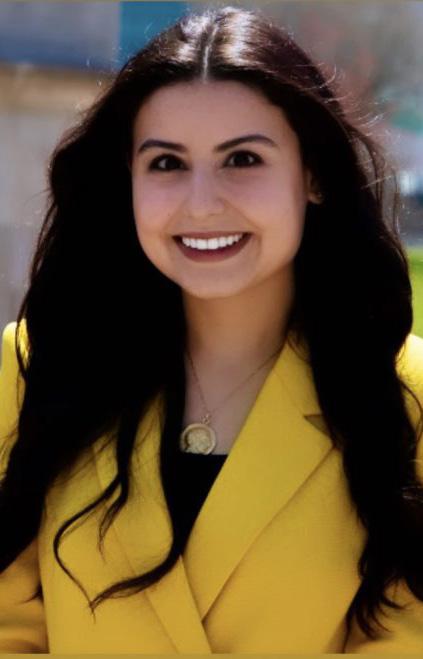 PHOTO BY CHRIS ESTRADA
PHOTO BY CHRIS ESTRADA
CAMPUS JANUARY 11, 2023 | 3
Gabrielle Abdelmessih is the editor-in-chief of The Oakland Post for the 2022-2023 academic year. She is a senior majoring in biomedical sciences and minoring in journalism.
How students can eat fresh on campus
AUTUMN OKUSZKA
Features Reporter
With the hectic schedule of a college student, it can be easy to fall into unhealthy eating habits. On top of classes, projects and tests, what a student eats might be the last thing on their mind.
For golden grizzlies, Oakland University students can rest assured that they can maintain a healthy diet with cuisines from all across the world they have to choose from on or around campus.

Below is a list of local restaurants that students can dine at to maintain their health while maintaining their responsibilities.
The Halal Shack, Oakland Center
The Halal Shack transcends cultures by combining Mediterranean, Middle Eastern and American flavors for those dining in the Oakland Center. They offer locally sourced ingredients, humanely treated meat as well as vegan and vegetarian options. The Halal Shack not only caters to Islamic dietary guidelines, but to those looking for a healthy option close by as well.
Clean Eatz , 1194 Walton Blvd., Rochester Hills, MI 48307
Clean Eatz has an abundance of options when it comes to healthy eating including a dine-in cafe, grab ‘n’ go meals and weekly meal plans. They use fresh, seasonal ingredients with gluten-free, keto and high-protein options. Clean Eatz crafts nutritional products and fitness opportunities that meet the needs of every type of lifestyle, believing that personal wellness is not one-size-fits-all.
Tropical Smoothie Cafe , 1288 Walton Blvd.,
Rochester Hills, MI 48307
Bringing the tropics to the cold climate of Michigan, Tropical Smoothie Cafe’s smoothies, sandwiches, wraps and flatbreads are made-toorder. With vegetarian and gluten-friendly options, Tropical Smoothie is committed to sourcing safe and quality ingredients.
Vandenberg, Hillcrest Dining Hall
OU’s dining halls serve cage-free shell eggs, certified humane beef patties, support and purchase from local farms and that’s only the tip of the
iceberg. Vandenberg and Hillcrest Dining Hall also accommodate food allergies and have vegan, vegetarian and gluten-free food options. The dining halls are also beginning to roll out the user and climate friendly Reuse Pass Program.
Chomp , 200 S. Main St., Rochester, MI 48307
Located in the heart of downtown Rochester, Chomp is a vegan, gluten-free and dairy-free restaurant that offers a wide variety of plant-based foods. Established in 2010, Chomp is also a familyowned-and-operated business that has a menu that’s primarily made in-house and features locally grown vegetables when available.
Beyond Juicery + Eatery , 3080 Walton Blvd., Rochester Hills, MI 48309
Beyond Juicery + Eatery offers salads, wraps, smoothies, bottled juices, wellness shots and even an opportunity to purchase a juice cleanse package. Beyond Juicery + Eatery is also committed to aiding the community around them as they collaborate with Rising Stars Academy, a school located in Center Line, MI that’s dedicated to helping disabled adults learn necessary skills to participate in the community. The school produces over 10,000 pieces of product for the restaurant monthly.
Subway , Oakland Center
Just a hop, skip and a jump away from Halal Shack, the Oakland Center also houses Subway where students can “eat fresh.” In fact, the chain restaurant came to fruition as a way to raise money for co-founder Fred DeLuca’s college tuition. With subs, melts, wraps and salads on the menu, Subway offers freshly made, convenient and affordable food.
OU Counseling Center providing services to students in need
ARIANNA HEYMAN Features Editor
According to a study done by the American College Health Association, nearly three quarters of students reported struggling with moderate or severe psychological distress.
Dr. David Schwartz, director of the OU Counseling Center, says that anxiety, imposter syndrome and stress relating to school and performance is more common than people realize. The mental health of students is a worsening issue, and university health clinics like the OU Counseling Center are finding new ways to help their students in need.
The OU Counseling Center offers a broad range of mental health services to students which include personal counseling, psychological and psychoeducational testing, career testing and counseling, substance abuse evaluation, treatment, and prevention, consultation and outreach and crisis intervention.
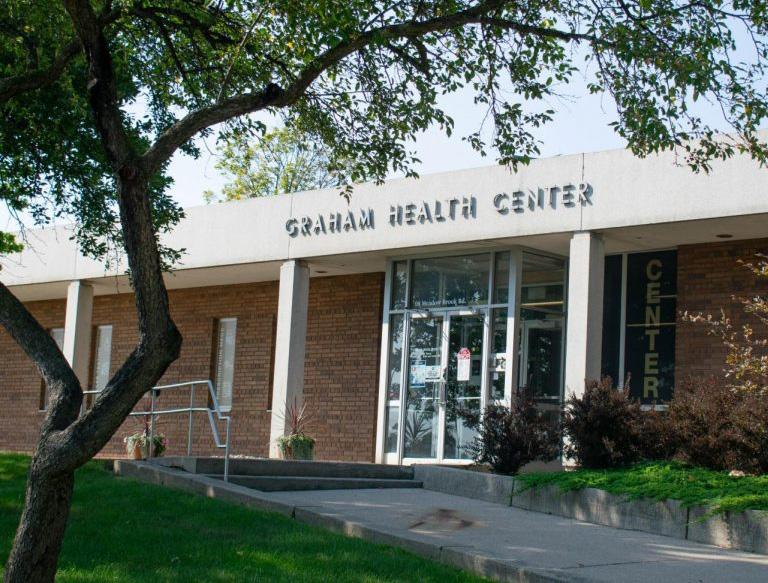
At OU, students are eligible for four free therapy sessions and then must pay a $20 copay for each additional session.
“I always like to mention this –– we work with students who might not be able to afford that $20 if they want to continue meeting beyond the free sessions,” Schwartz said. “Our policy is we never turn away students for financial reasons.”
Schwartz also mentions the benefits of group therapy. OU currently offers six different groups for students to join which are set up as a
psychoeducational support mixture.
“We have a rotating schedule of different topics the groups might have. Our most popular group for example is a group for any students who are dealing with anything related to school that is causing them any type of negative impact on their emotional wellbeing. So it covers topics like study skills, time management, testing anxiety, imposter syndrome –– all the very common things that students often struggle with.”
Schwartz notes that taking advantage of these services is important in order to combat the growing mental health problem among students who suffer in silence more often than not.
“I think just below 60% of all college students at some point in their college career experience significant or severe depression. When I say significant depression, I mean it’s to the point where it’s actually significantly impacting their functioning either in relationships or school or work.”
Despite the progress, Schwartz believes our society has a long way to go in order to create an environment where people feel comfortable enough to discuss their suicidal thoughts.
“One thing we do know is one of the best protective factors that stops people from acting on those thoughts is having somebody ask them about it and being able to talk about it with somebody. When I have my first session with clients, I like to go over this stuff right at the first session just to normalize it.”
Schwartz also knows that many are wary of
therapy and its benefits. He wants to combat the stereotypes that some have about psychologists.
[People] build up in their mind what is therapy like and they have this picture from movies and television and it’s usually not at all like it. None of us smoke pipes, we don’t all just sit and stare at you –– we’re very charismatic, friendly people [and] we genuinely love talking to people. We love our jobs and most people find that it’s pretty easy to talk to us.”
(Continue on our website)
PHOTO BY The American Heart Association.
PHOTO BY Maggie Willard
CAMPUS 4 | JANUARY 11, 2023
The OU Counseling Center (OUCC) is offering free therapy sessions to OU students.
The triple threat: How students maintain their classes, grades and health
Autumn Okuszka Features Reporter
Eat, sleep, repeat. Or more familiarly to students across the nation — eat, study, sleep, repeat.
It’s a cycle that preoccupies so many students that they often neglect themselves and their physical and mental health. However, it’s a cycle that can be broken as Oakland University students have found ways to prioritize themselves while also making sure they get their diploma come graduation day.

Sophomore Valerie Aljajawi says the gym is her safe haven when she’s not studying. It’s a place she goes to ensure she is taking care of herself while also taking care of her classes and grades.
“It sounds so cliche to say, ‘oh, just go to the gym, it’ll make you feel better,’ but it’s so true,” Aljajawi said. “I find that when I [go] to the gym, I feel better, I sleep better.”
Although he partakes in hobbies such as tennis and snowboarding, senior Yardley Resendiz also finds refuge in going to the gym.
“I think it’s good to set aside a scheduled time [to go to the gym],” Resendiz said. “Whether that be a couple days in the week [or] whenever you can find time.”
While exercising helps Aljajawi and Resendiz break up the monotony, senior Esme Lowy intends to stay healthy by maintaining a good diet.
“I try to eat well,” Lowy said. “If you eat at the dining [halls], I usually eat a salad everyday in addition to the other stuff [they have there] because it usually helps.”
Senior Ethan Wyatt is also cautious of what he puts into his body, especially drinks.
“I switched to only drinking water in my freshman year, that helped,” Wyatt said.
While it is important to maintain physical health, what is equally if not more important is maintaining
mental health. According to a study by The Healthy Minds Network, 41% of college students experience depression and 34% experience anxiety nationwide.

Junior Tyliah Weathersby makes an effort to maintain her mental health by attending counseling sessions offered at the OU Counseling Center, which she says helps a lot. For students struggling with their mental health, Weathersby advises to put yourself first above all else.
“Set priorities for yourself,” Weathersby said.
“If you know that you just can’t, don’t try to force it. Give yourself a break. Or, give yourself little rewards to help yourself feel accomplished.”
Junior Kennedy Aiello has dealt with depression and anxiety and believes it’s important to know that you’re not alone. She’s thankful for the abundance of mental health advocacy online.
“I’ve had mental health problems and I think it just helps in general because there’s a lot of advocacy online so people know they don’t [have to] feel alone,” Aiello said. “Everyone is going through something horrible so I think the first step too is just realizing you’re not alone and it’s not a bad thing.”
For students looking to maintain their physical health, they can visit the Recreation and Athletics Center. For students needing mental health support, they can visit the OU Counseling Center where the first four sessions are free.
CAMPUS JANUARY 11, 2023 | 5
Behavioral Health Equity Research Group.
Girl Gains: New organization for women weightlifters
Brock Heilig Sports Editor
Oakland University prides itself on being a school with a vast majority of clubs for its diverse group of students to participate in.
Girl Gains, a new organization started by Samantha Hadyniak, is a weightlifting club open to any women at Oakland that would like to get involved with lifting weights.

Talks of starting the organization started in January of 2022, but the club didn’t officially launch until the 2022 fall semester.
Ironically, the club started more than 2,000 miles away, in California, Hadyniak said.
“This club was actually started as SDSU in California,” Hadyniak said. “So it’s a national organization and we are just, like, a chapter of it at Oakland.”
Hadyniak went on to share an interesting story about how she first had the idea of bringing Girl Gains to Oakland.
“I actually found a Tik Tok,” Hadyniak said. “The girl, her name is Elisabeth Bradley, she’s the one who started it as SDSU, and I was just scrolling on my page and it popped up and it was like, ‘do you want to start a women’s weightlifting club?’ and at the time I was really getting into fitness and getting in the weight room and stuff like that, and I just kind of took a leap and went to the link that was in her bio and filled out the application to start my own chapter, and we have spiraled since then.”
She went on to explain that, although the club is only turning one year old this month, they have quite a large number of girls interested in what is being started.
“We had 112 girls in our GroupMe chat, and then there were like 55 members registered on Grizzorgs… we were just right at about 300 followers on Instagram.”
Hadyniak is a senior and will graduate in just a few months, so this will be her last semester as president of the club, but she seems to have already picked out her eventual successor — Jenny Ognjanovski.
Ognjanovski is a sophomore, and she is ready to take over the
organization once Hadyniak departs.
“[Hadyniak] originally asked me to fulfill a position of vice president, and I actually had been wanting to start getting into working out. I did it with my friends, but I never really knew exactly how to properly work out.”
As for Ognjanovski’s plans for the organization after Hadyniak graduates, she says she wants to hit on two major areas: fundraising and getting more girls involved.
“Fundraising would be awesome, and also just getting more of the girls involved,” Ognjanovski said. “I feel like a lot of people don’t really know about the club, and it’s just an awesome club to get involved with.”
“A lot of girls have a hard time starting with working out and knowing where to begin, so honestly, I think it’s just spreading the word more… That’ll be my biggest goal.”
As for the present, Hadyniak wants to make sure that in her last few months as president, all women feel welcomed and included.
“We’re really focused on being inclusive to everyone,” Hadyniak said. “So, we don’t want anyone to feel like they can’t join, even if they’re a beginner in fitness or even a powerlifter. We want everyone to be able to come and join the community, at any fitness level.”
Environmental wellness: A simple guide to decluttering your living space
Payton Bucki Campus Reporter
As we step into the new year, resolutions abound. Consider decluttering your environment for a simple, inexpensive fresh start that may have a direct positive impact on your mental health.
Overconsumption is an issue that harms the natural environment and damages the mental and physical health of consumers. This decluttering guide provides helpful tools for mitigating overconsumption by introducing an intentional process of sorting through their material goods and digital applications.

Physical Clutter
Physical clutter can be defined as material goods not being used consistently and purposefully in your life. When sorting through physical clutter, it is beneficial to ask mindful questions regarding your utilization of said items, like: “How often do I use this?” or “Does this item have a place or take up space?”
After sorting through your items, you may wonder what to do with the items considered clutter. “Do you simply trash everything?” the short answer to this question is “no”; it is important to dispose of your clutter ethically.
There are many ways to practice ethical disposal. For those with a crafty side, it may be best to upcycle, which is the practice of reusing materials to add personal value to the item.
Another way to dispose of clutter is by donating the items to a friend, family member, or thrift shop. Individuals may even decide to sell their items through an online sales application or website. As the saying goes, “one man’s trash is another man’s treasure.”
Digital Clutter
Another significant type of clutter is digital clutter, which consists of the disorganization of the applications and data on your technology devices. Examples of digital clutter may include an overflowing email inbox or an array of unused phone apps.
In order to declutter your technological spaces, it may be best to complete a digital sweep of your devices. This process consists of deleting unnecessary files, applications and stored data.
There are many benefits to
eliminating digital clutter, including reduced stress levels, higher productivity and increased device speed. Additionally, digital decluttering benefits the environment by reducing global greenhouse gas emissions, since massive amounts of energy are used to store technological data.
Emotional Clutter
Emotional clutter can be characterized as thoughts that tend to negatively affect one’s mental health and well-being. While emotional clutter is not tangible, it is essential to recognize and let go of these draining emotions.
In order to rid yourself of emotional clutter, practice intentional self reflection. This practice involves actively processing your thoughts and feelings.
“After coming to OU, I have been able to have conversations regarding self reflection with a wide array of individuals,” Oakland University sophomore Calla Bazinski said. “It is comforting to be able to have these deep conversations in a supportive, nonjudgemental environment.”
When you recognize yourself experiencing a negative mindset, attempt to identify the cause of this emotion. Once you are able to consciously examine your emotional clutter, let go of these feelings and try to shift to a positive alternative.
PHOTO BY THE OAKLAND POST
POST FEATURES 6 | JANUARY 11, 2023
PHOTO BY THE OAKLAND
What is buccal fat removal — TikTok’s latest plastic surgery fad?
TORI COKER Content Editor
Move over, Brazilian Butt Lift, TikTok has a new plastic surgery fixation taking the app by storm — buccal fat removal.
Everyone’s face comes with buccal fat pads stored within the muscles of their cheeks, between the cheekbones and jaw. The prominence of these pads varies person to person and is not typically subject to change with weight loss or gain.
Some patients pursue cosmetic surgery to remove buccal fat pads — most often for the purpose of hollowing out the area to achieve a more contoured look.
“That’s done through a small incision through the inside of the cheek, right below where your parotid gland – the salivary gland in your cheek — drains into the cheek,” Dr. Ashley Guthrie, a facial plastic surgeon and OUWB alum, said. “[The incision] is stitched back up with dissolvable stitches, [and] the recovery time is about two weeks of some swelling and mild discomfort. It takes about an hour and is usually just done in the office under local anesthesia.”
The procedure has been around for much longer than TikTok, though the app fell recently obsessed after users noticed actress Lea Michele sporting a more sculpted look in a selfie posted to her Instagram in December. While the hype around this particular post is merely speculative, buccal fat removal did receive a celebrity endorsement last year when model Chrissy Teigen revealed she’d undergone the procedure.
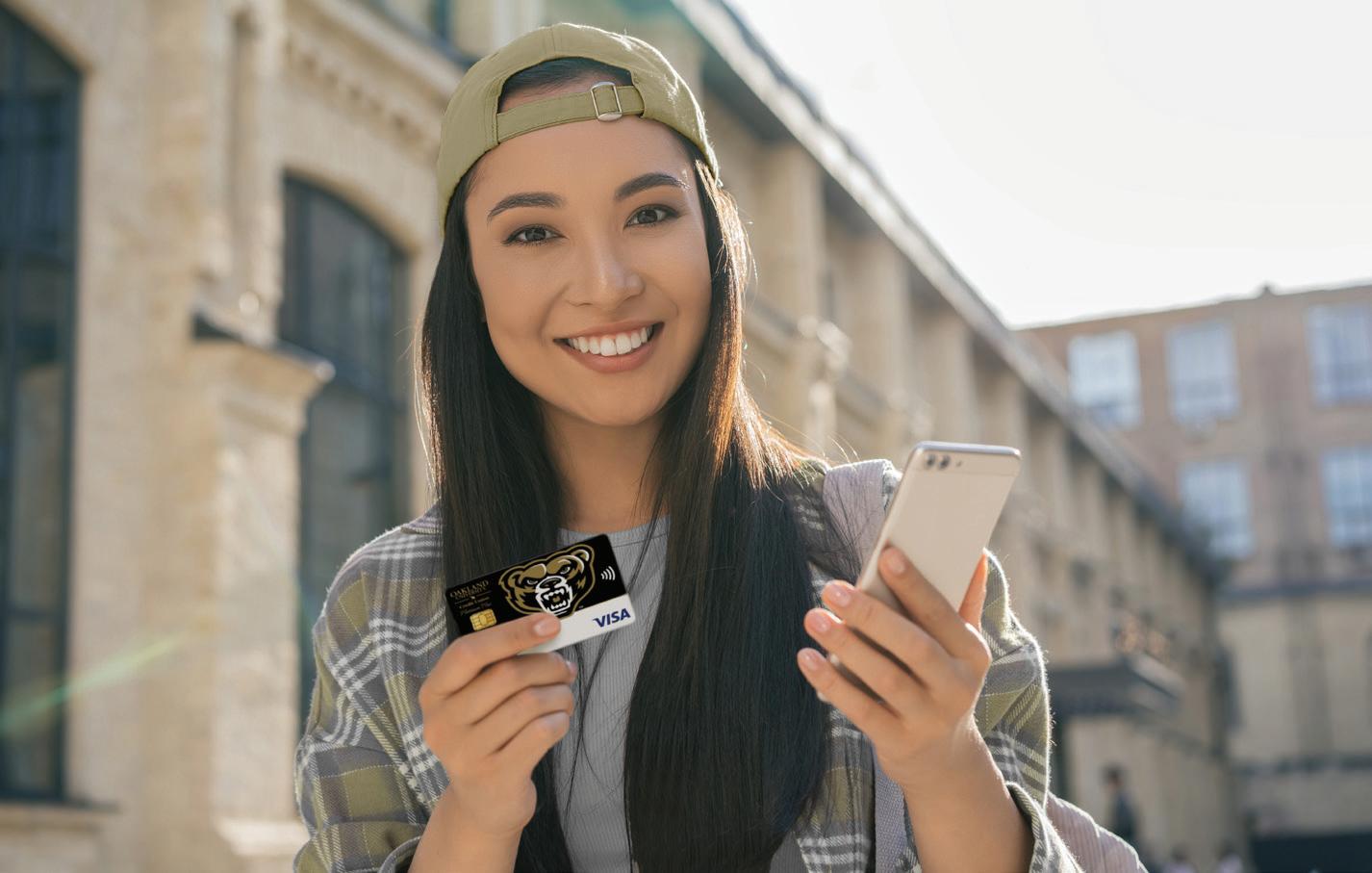
According to the American Society of Plastic Surgeons, those with naturally narrow faces are typically
not considered good candidates for buccal fat removal, as this part of the face thins gradually with age and removal of this fat could contribute to a gaunter appearance over time. Some critics of the procedure’s romanticization across TikTok cite this risk as a central reason the trend is dangerous to perpetuate in a space so intensely populated by young people, while also denouncing the implication that rounder faces are less appealing.
“I’m almost 30 and I look young as f**k, and you know why? These freaking cheek-ies, baby!” skincare content creator Rachel Finley said via her TikTok profile @hydrationceo. “Please do not make an irreversible change to your body because of a trend.”
Finley’s comment illuminates another part of the procedure medical experts urge young people to be aware of — its permanency. While the upper cheekbone and jaw areas can be altered with filler, the area of the cheek where buccal fat resides does not respond well to filler — so once you remove the fat there, it cannot be restored.
“You don’t want to do it as a result of a fad and then, down the line, be sorry that you did it or come to find out that really wasn’t what you needed,” Guthrie said. “Things like filler and botox and those kind of things — there’s less risk in trying to be trendy with them because they’re temporary, but when you talk about doing actual surgical procedures where you’re permanently altering your face, it needs to be something that’s thought about for a long time.”
Buccal fat removal is merely the latest in a long line of cosmetic surgery and treatment trends to generate buzz across social media. Its predecessors include procedures that have been household names for longer, such as rhinoplasty and lip injections, as well as more recent phenomena, such as the double-chin targeting,

nonsurgical kybella procedure.
Often, what’s trending in plastic surgery changes tunes and contradicts itself just as quickly as the initial trend developed. This past year, TikTok claimed rumors suggesting several Kardashians had gotten their Brazilian Butt Lifts (BBL) reversed meant we had reached “the end of the BBL era.” So if you’d gotten the procedure because TikTok told you it was ‘in’ during June only to hear it was ‘out’ come August… welcome to TikTok.
Guthrie says TikTok trends like this one do impact the types of questions posed and desired results requested by patients during a given time — though never her professional process for determining which surgery is right for a particular patient.
“My judgment is going to be the same whether they want it because they saw it on TikTok or not,” Guthrie said. “I’m still going to evaluate them and determine whether I think it’s appropriate or not, but it definitely increases the number of those conversations — not necessarily the number of surgeries that are performed.”
Guthrie urges young people to see beyond the changing tides of their ‘For You’ pages and consider that there is no one-size-fits-all approach to beauty or plastic surgery.
“While TikTok and social media platforms definitely have a positive role in some things, I think they can be dangerous, as well, in terms of influencing young people to feel that they need to have these different procedures in order to be beautiful or attractive and become somewhat of a thing of everyone trying to achieve the same, exact, standard look, which isn’t necessarily what’s good for everyone,” Guthrie said. “Everyone has a different face shape, everyone is beautiful in a different way, and I shy away from making everyone look like a cookie cutter.”
SCITECH JANUARY 11, 2023 | 7 • Apply for your OU Platinum Plus Visa Credit Card. • Receive 1% cash back on ALL purchases once approved.1 • Rates as low as 13.90% APR.2 OU Credit Union Platinum Plus Visa cardholders will earn 1% cash back on all purchases. Cash back is not earned on tax payments, any unauthorized charges or transactions, cash advances, convenience checks, balance transfers, or fees of any kind. Account must be in good standing to redeem cash back. Returns result in the loss of cash back equal to the amount returned. Negative cash back will be given if returns or credits exceed purchases. 2 Annual Percentage Rate (APR) of 13.90% is lowest rate offered for OU Credit Union Platinum Plus Visa Credit Card. Actual rate determined by member’s credit score. We CU SHOWING YOUR GRIZZLY SPIRIT. oucreditunion.org | 248-364-4708 | Visit a branch
OU Rec Center events and programs to stay busy this semester
The top New Year’s resolutions for 2023 are all about living healthier, like exercising more and losing weight. Those on campus can tackle those resolutions at Oakland University Recreation and Well-Being.
OU Rec Well has opportunities lined up all semester for students, faculty, staff and the community to engage in physical and mental well-being. All programs and sports mentioned below can be found at myrecwell.oakland.edu or through the app.
Rec Well Sports
Whether it be for a league or a one day tournament, Rec Well Sports has new and returning events for students of OU. The first one night event will be an NBA 2K Xbox tournament on Jan. 18, with League of Legends and Overwatch being later in the semester.
As for leagues, the semester kicks off with fan favorites 5 vs. 5 basketball and 5 vs. 5 indoor soccer. The registration deadline is Jan. 26 at midnight, and basketball already has some spots taken. “In March, we will go back outside and bring a new team sport to the lineup in 4 vs. 4 flag football and 4 vs. 4 indoor floor hockey, both utilizing smaller spaces and fields while still bringing you classic sports that participants have come to enjoy,” Kyle Reece, sports and recreation program coordinator, said. New events coming to OU include; 3 vs. 3 extreme dodgeball, which will be in the racquetball court, soccer tennis, a pickleball tournament and a cornhole tournament. All dates and times for the events can be found on the registration page of the website. For more information about how to register, there is an article explaining the whole process.
Fitness
For those who want to stay active but may not want to join a team, there are Group X opportunities all winter, with classes ranging from cycling to slow flow yoga. Dates and times can all be found on the program page.
In January, Rec Well will be offering Group X Happy Hour days, where any non-member 18 or older can come in with their ID and gain access to all Group X classes in a certain day. The
Happy Hour dates include Jan. 13, 18, 20, 24, 26 and the 30. One upcoming program is the Be My Yoga Valentine, which takes place on Feb. 15 and will be part of the annual Love Well week from Feb. 13 through the 17.
If you are just getting started or you want a helping hand while you work out, Rec Well is accepting personal training client applications. Personal training can be solo, with a buddy or in a group. For any questions regarding personal training, Group X or fitness programs, email Hailey Monroe, fitness programs and services coordinator, at hmonroe@oakland.edu.
Well-Being
Student well-being at Rec Well comes in multiple forms like bright light therapy, wellness coaching, the Green Bandana Project and pet therapy. Throughout the semester, there will be plenty of opportunities for pet therapy with the closest one being Jan. 19 at noon in the Habitat.
To view upcoming programs like the Wellness Winter Wonderland — which takes place on Feb. 21 — students can go to the program page on the website. To submit requests for a program or to learn more, students can email Cortney Heileman, assistant director fitness and well-being, at cheileman@oakland.edu.
Students are not the only ones who can take advantage of well-being opportunities, as Caitlyn Hennings, wellness and educational outreach coordinator, helps create programs for employees as well.
Some new programs this semester are the OU Employee Book Club, Priority Health Goal Setting workshop and the Understanding the Risk of Pancreatic Cancer workshop.
“Our Employee Book Club will allow colleagues to come together and connect over similar interests,” Hennings said. “Our Priority Health workshop will allow people to gain points toward qualifying for their insurance.”
Returning programs are the Couch to 5k, Gratitude grams and the Employee Ergonomic program. Email chennings@oakland. edu for any questions regarding employee well-being.
STORY BY JOE ZERILLI | PHOTOS BY MAGGIE WILLARD AND LINDSEY SOBKOWSKI | DESIGN BY MEGAN PARKER
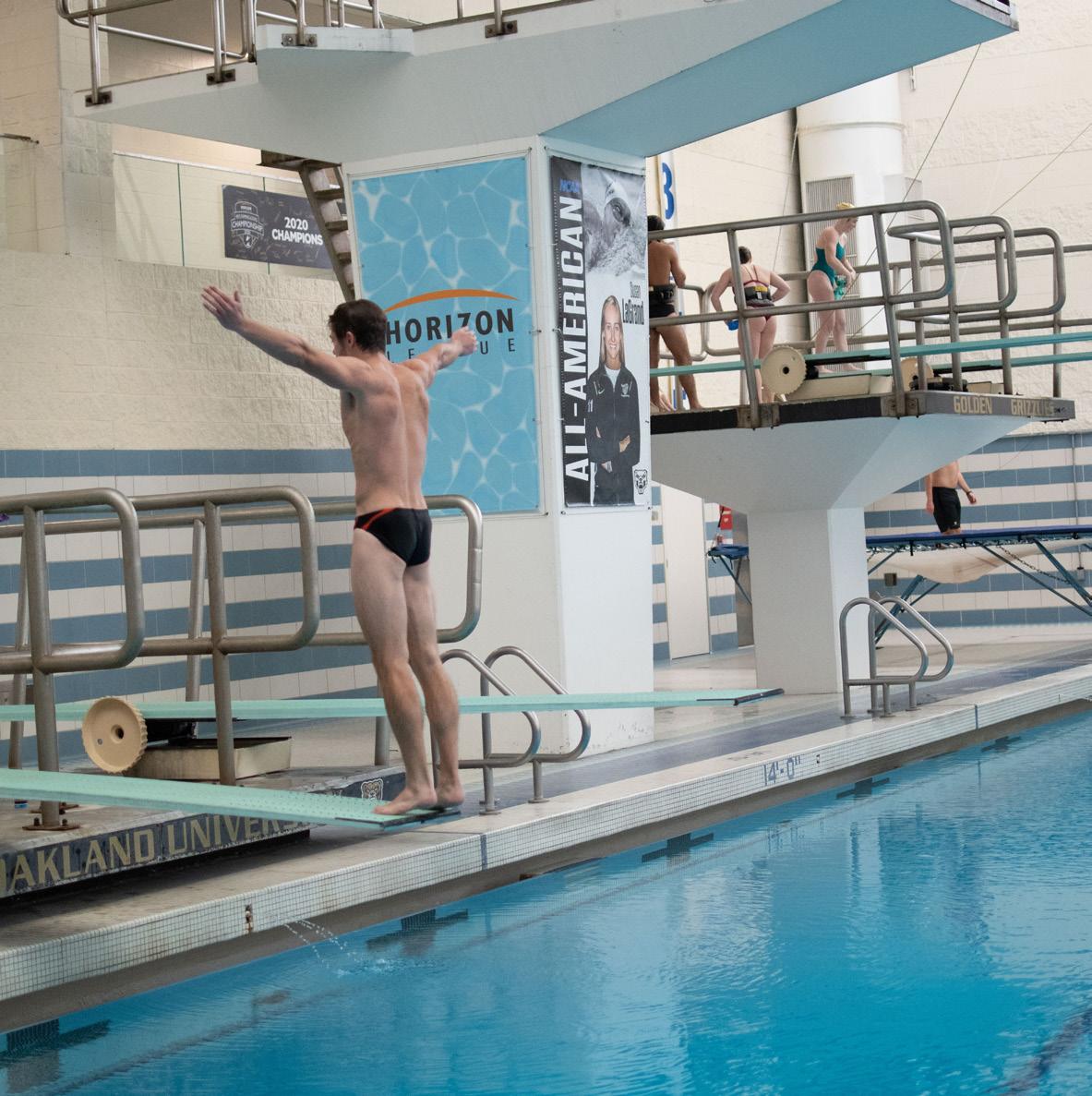
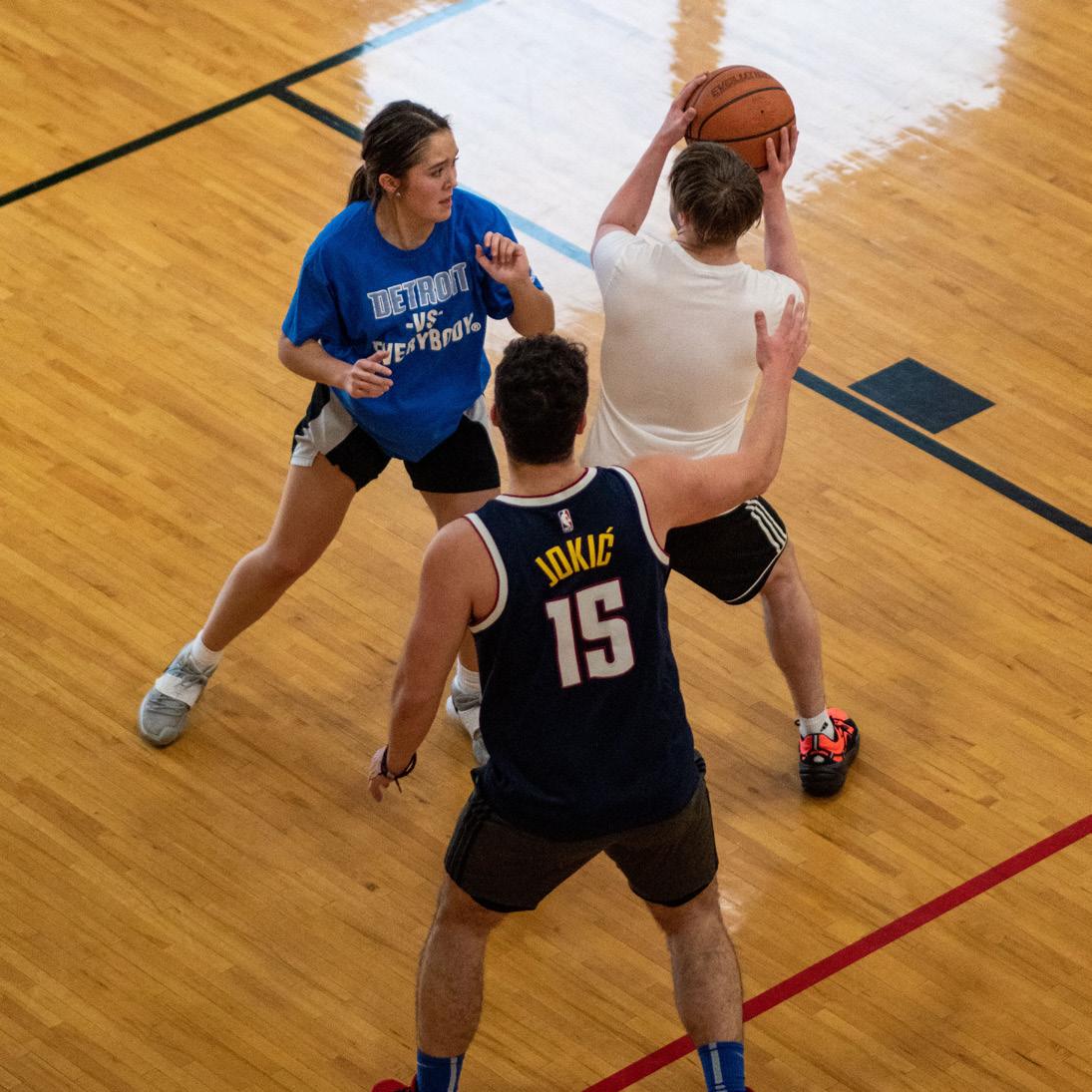
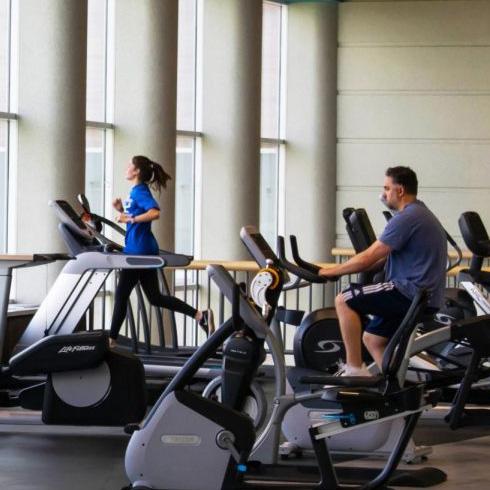
Ophthalmologist Dr. Vrabec shares eye health tips for college students
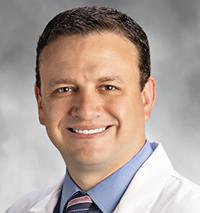
GABRIELLE ABDELMESSIH
Editor-in-Chief
A college schedule is a busy schedule. With all of the time spent interacting with a digital screen, whether for education, communication, or entertainment purposes or through utilizing books and other study aids, our eye health can be overlooked. I spoke to Dr. Joshua Vrabec, a Board-Certified Ophthalmologist at Michigan ophthalmology, about what college students can do to protect their short and long-term eye health.
Q: What are some of the factors that can contribute to poor eye health in college students? How can students protect their eyes?
A: The most common reason for permanent vision impairment in college-aged adults are injuries. Over 1 million eye injuries occur each year, and 90% of these are preventable. The most important way to protect your eyes is to wear safety glasses while working with machinery, power tools, or even hand tools. Another common cause of problems is wearing contact lenses too long, or worse, sleeping in your contacts. This can lead to cornea infections (ulcers) which
can permanently impair vision for life. Young adults who have trouble maintaining good contact lens habits may want to consider laser vision correction such as LASIK.
Q: How often should one get their eyes checked?
A: It depends. If you have a medical problem like diabetes or autoimmune disease, you should have your eyes examined once per year. Similarly, if you wear contacts, you should have your eyes checked annually to make sure the lenses are still fitting well to minimize complications. If you have none of the above, you should consider an eye exam once every five years.
Q: Why shouldn’t one sleep in their contact lenses?
A: Sleeping in contact lenses greatly reduces the oxygen absorption into the corneal epithelial cells, which causes them to more easily break down and become infected by bacteria. This leads to corneal inflammation (keratitis) or infection (ulcer). Treatment for ulcers can be very difficult, and may lead to permanent vision issues and may prevent you from having a vision correction procedure in the future.
Q: Does taking measures to ensure good eye health now have
an impact on your future health? Is there anything else you think college students should know about their eye health?
A: Taking great care of your eyes now is an investment in your future. Sadly I have witnessed many examples of students whom have had tragic accidents that permanently impacted their vision. This can result in excluding you from certain careers in the military, aviation, and some
medical fields. The vast majority of these tragic injuries could have been prevented simply by wearing eye protection, or being more careful with contact lens wear. I also get asked frequently about the dangers of computer and phone screens, and so far the jury is still out. Generally, it’s a good idea to give your near focus mechanism (accommodation) frequent breaks to avoid eyestrain, but there has not been definitive benefit seen from computer or blue-light blocking glasses to date.
I also frequently get asked by college students about LASIK, and specifically whether it is safe. The answer is that yes, in the proper candidate, laser vision correction (particularly the most modern versions of the procedure) is incredibly precise and safe. It has been FDA-approved for over 20 years, and with can be a great way to free yourself from the inconveniences and costs of glasses and contacts. Anyone who has additional questions about laser vision correction or LASIK, including whether they might be a candidate, is welcome to contact our office at 248-710-2323 or contact us via our website: http://mieyedoc.com
‘A Grizzly’s Guide to a Healthier Y(OU)’: Healthy habits to pick up in college
GABRIELLE ABDELMESSIH Editor-in-Chief
You are what you eat. Well, maybe not literally, but what you eat can have short and long-term health consequences.
Eating healthy can reduce one’s risk of heart disease, stroke, diabetes, some cancers and other health conditions. While more research about this link needs to be conducted, current studies suggest that foods high in components like sugar, salt, saturated fats and trans fats can have negative impacts. It is important to point out that this is not specific to any one person’s individual risks, genetic factors and physical activity levels, and that you should always consult with a healthcare professional about your particular dietary needs.
Exercise is associated with a decreased risk of chronic diseases, too.
Yes, it seems like a no-brainer that eating healthy foods and exercising is better for you, but what isn’t always acknowledged is the amount of time, money and access that is required to do so.
For this week’s column, I spoke to Dr. George Howard, chief of the Department of Hematology and Oncology — Beaumont Troy, about what tangible and practical steps college students can take to improve their overall health, as well as share some free resources available to OU students that can help in reaching that goal.
Whether it be developing healthy eating habits, an exercise routine, or limiting alcohol and tobacco
consumption, Dr. Howard emphasized the importance of establishing a routine as a young adult.
So, how do we fit this into our college schedule and budget? Let’s discuss:
Healthy Eating Habits
“The path to health when you’re older starts when you’re making decisions long term about your dietary choices, ” Dr. Howard stressed. According to Dr. Howard, incorporating whole-food plant-based foods into your diet and reducing consumption of food low in nutrients (minerals, vitamins, and fibers) is a good place to start. “Keeping as whole food a diet as possible is going to lead to all sorts of long-term health outcomes,” he said. Meal prepping and having healthier snacks like fruit and unsalted nuts readily available to grab and go can help save some time and kudos to Gen-Z, we tend to already prefer plant-forward meals while also taking pricing and sustainability into account.
Limiting
Alcohol and Tobacco Consumption
Alcohol and its potential sugary mixers are also risk factors for chronic health conditions. It doesn’t mean that it can’t be enjoyed responsibly and safely in moderation, but higher consumption levels increase the risks. Limiting other sugary beverages like soda and coffee drinks should be considered as well. Note to self: less Starbucks, more water!
Tobacco causes short and long-term damage, including cardiovascular damage, cancer and potentially a nicotine addiction that can prolong usage. Oakland University is a smoke-free campus.
Exercise
“You only benefit yourself, from the perspective
of energy, brain functioning, good sleep and cardiovascular health through excessing,” Dr. Howard emphasized. For adults over the age of 18, 150 minutes of cardio activity (a brisk walk, jogging, swimming, etc.) is recommended a week along with two days a week of activities that strengthen muscles (lifting weights, climbing stairs, yoga, etc.). This doesn’t have to take place all at once. Try adding two or three short workout sessions a day. It adds up! That 10-minute walk to and from your car thanks to the joy that happens to be OU parking lots? Consider it part of your exercise routine.
These suggestions might seem like just the basics of good health practices, but developing healthy habits earlier in life is fundamental to long-term health and wellness.
If you have any questions or suggestions for future columns, email me: gabdelmessih@oakland. edu. My goal is to make “A Grizzly’s Guide to a Healthier Y(OU)” as helpful as it can be for the university community.
On-Campus Resources:
Golden Grizzlies Pantry
OU Counseling Center
Oakland University Recreation Center
Office for Student Involvement
SCITECH 10 | JANUARY 11, 2023
PHOTO COURTESY OF BEAUMONT Dr. Joshua Vrabec talks ophthalmology and eye health.
Discussing all things skincare with Dr. Fatima Fahs
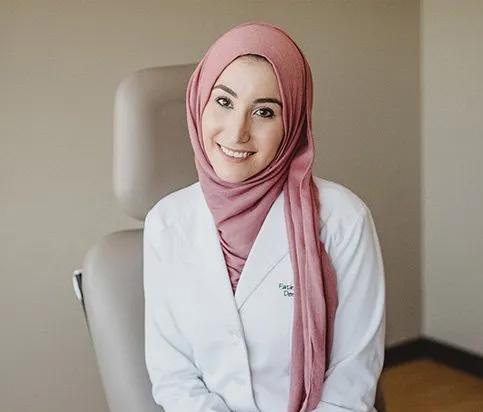 GABRIELLE ABDELMESSIH Editor-in-Chief
GABRIELLE ABDELMESSIH Editor-in-Chief
Are you obsessed with skincare? Me too. And we’re not alone. When I mentioned I was interviewing a dermatologist about skincare for college students, it certainly sparked the interest of many of our staff!
Gen-Z is enthusiastic for all things skincare, with many buying products recommended from influencers from social media. Whether you’re watching Youtube videos, or scrolling through Instagram or TikTok, one is bound to come across skincare content. There is a seemingly endless list of varying routines, product recommendations, and (sometimes dangerous!) trends to try. With all of that scrolling, comes a lot of questions. How elaborate does my skincare routine need to be? Should I wear sunscreen? How can I take care of my skin without spending too much time or money?
It can be overwhelming and hard to decipher between fiction and fact. To help clear some of that confusion, I asked Dr. Fatima Fahs, a board-certified dermatologist and clinical professor at the Oakland William Beaumont School of Medicine (OUWB) some questions. Here’s our conversation:
Abdelmessih : Why did you decide to join social media as a dermatologist?
Dr. Fahs: I created my Instagram account, @dermy_doctor, in 2017 while I was in dermatology residency as a means for creative outlet and expression. I quickly realized that it was an awesome platform to educate the masses when it came to all things skin. I harnessed that to create posts on topics such as different types of skin cancer, risks for developing skin cancer and how to choose the right sunscreen — it just took off from there!
Abdelmessih: On social media platforms like Instagram and Tik Tok, it is — unfortunately — common to come across risky skincare trends. Where and/or whom can people get science-backed content from on these platforms or elsewhere?
Dr. Fahs: I think it’s important to take everything you see on social media with a grain of salt. This is not a peer-reviewed publication, any and everything goes when it comes to posting online! So if something sounds really outrageous, then it probably is. I think it’s exhausting to always fact check, so instead,
I recommend people take these questions to their own doctor if they have doubts or concerns. Remember, you should never be seeking personal medical advice on social media, nothing replaces an in office exam and discussion with your doctor.
Abdelmessih: There are so many skincare products on the market that it can feel overwhelming when trying to figure out a skincare routine. What is a basic skincare guide morning routine and night routine that you recommend for college students?
Dr. Fahs: I remember waking up in college, splashing water in my face and heading out the door to class! I also slept in my makeup plenty of times — oops! I think it can be very overwhelming to try and make an elaborate skincare routine in college — and you really don’t need to. In the morning, aim for 3 steps: gentle cleanser, an antioxidant product (like a vitamin C serum) and a moisturizer that contains sunscreen. In the evening, make sure to cleanse your skin before heading to bed, especially if you’re wearing makeup. If you have energy for a few more steps then consider adding in a topical retinoid (this decreases oil production and acne, helps with hyperpigmentation and promotes collagen production over time) and top it all with a moisturizer. You don’t need to spend a ton of money on skincare for it to be good, there are plenty of great drugstore brands that are affordable for a college student’s budget.
Abdelmessih: Why is sunscreen so important and why should we wear it daily? What’s the difference between chemical and physical sunscreen and how should one choose which to use?
Dr. Fahs: Skin cancer is the number one cancer in the US with 1 in 5 Americans developing skin cancer in their lifetime. One blistering sunburn in childhood or adolescence can nearly double a person’s chance of developing melanoma, the deadliest form of skin cancer. Wearing sunscreen daily can significantly reduce your risk of developing skin cancer. But you know what else it does too? Reduce your risk of premature aging! Heavy sun exposure over time breaks down collagen and leads to premature fine lines, wrinkles, leathery skin and more.
Chemical sunscreens contain ingredients like oxybenzone,
avobenzone, octisalate, octocrylene, homosalate, octinoxate, etc. Mineral sunscreens contain zinc oxide and/or titanium dioxide. In general, we tend to find that mineral sunscreens are more suitable for those with sensitive skin as well as babies/kids. More importantly though, you should check your sunscreen label for 3 things. 1) Make sure it says “broad spectrum”, this means it protects against both UVA and UVB rays. 2) Make sure it contains an SPF of 30 or higher, this will mean that it blocks out about 97% of UVB rays (no sunscreen can offer 100% protection). 3) If using it for water activities or sweating, make sure your sunscreen says “water resistant” for 40 or 80 minutes.
Abdelmessih: Besides wearing sunscreen, what are other preventative measures one can take against skin cancer?
Dr. Fahs: Sunscreen is only the first step. Remember, a tan is considered DNA damage and DNA damage over time is what leads to skin cancer. So make sure you are also seeking shade (especially between the peak hours of 10am-2pm when the sun is the strongest), wearing sun protective clothing if you can (wide brim hat, sun glasses with UV protection, long sleeved shirts/pants) and reapply your sunscreen (every 2 hours when
outdoors). If you have a history of skin cancer in your family or many moles on your body, then it may be a good idea to establish with a board-certified dermatologist for a full body skin exam every year. If you use a tanning bad, please stop. Even one indoor tanning session can increase your risk of developing melanoma by 20%.
The main takeaway from this interview? Wear sunscreen!
If you have any suggestions for future column topics, please email me! My goal is to make this the most helpful it can be for the university community. Email: gabdelmessih@ oakland.edu
SCITECH JANUARY 11, 2023 | 11
PHOTO COURTESY OF HAMZAVI DERMATOLOGY
College students can use music and noise for stress-management
LETICIA CEZÁRIO SANTOS
Marketing Director
Coming to a university campus means seeing specific things that create the uniqueness of that environment. Usually, big buildings with many signs are a must.
But the people inside these buildings have unique characteristics that transform them into “college students.” From the many things college students can be recognized for, their laptops and headphones are, for sure, their best friends.
As college students, we are used to having tools we might have available for us every day. But what we lack many times is to find new ways of using these tools.
Even if we always have our laptops in hand for assignments, our phones for social engagement, and our headphones for entertainment, we rarely use these tools intentionally to increase well-being.
It’s important to differentiate escapism from wellbeing. We are used to using these technologies to escape our stressful days, but using them intentionally to improve well-being might look different.
College is the period in which we go through life changes, an increase in demands, exponential growth, and so much more.
“[...] the college years are also a time of increased risk of stressful events and a wide range of accompanying mental health challenges, including the risk of suicide,” wrote Johanna Younghans for Harvard Medical School.
As exciting as it can be, all the new things we have to deal with become stressful in less than a semester. As we learn how to deal with classes, we must know how to manage stressful days.
Among many things you can do to manage stress, intentionally using music and sounds might be an excellent strategy to give your brain time to rest.
“Music can have a profound effect on both the emotions and the body. Faster music can make you feel more alert and concentrate better. Upbeat music can make you feel more optimistic and positive about life. A slower tempo can quiet your mind and relax your muscles, making you feel soothed while releasing the stress of the day,” the University of Nevada published in a research, “Music is effective for relaxation and stress management.”
We are used to listening to music as entertainment or distraction. Still, music is proven to be a tool for well-being.
“We’ve found compelling evidence that musical interventions can play a healthcare role,” says Daniel J. Levitin, Ph.D., who studies the neuroscience of music at McGill University in Montreal for the American Psychological Association.
There are many ways to find music, but Spotify might give you easy access to focused material that you need on a busy day.
Between many titles, albums, and podcasts, Spotify has playlists built to serve a specific purpose. In this case, you will find different playlists focused on managing well-being.
See the list below: Stress Relief Totally Stress Free Ambient Relaxation Musical Therapy Anti-Anxiety
Besides the playlists made by the brand, you can also find thousands of playlists created by users with specific names.
In addition to music, sounds like White Noise might help you manage stress and/or anxiety.
“A 2018 study published by Oxford University Press showed white noise can improve functioning in adults with attention deficit disorder,” wrote Megan Nolan for The Guardian, “White noise is the only self-medication I have found that does me no actual harm.”
You can also find White Noise playlists on Spotify.
In summary, music and sounds can be used for more than entertainment. Nowadays, there is a lot of research and different methods to check how to apply music to manage well-being, mental disorders, and even our brain health.
Next time you feel like you need extra help, try to listen to a playlist.
*Music or any other tool does not solve mental health disorders, and this article does not mean by any means to propose it as a solution. College students suffering from anxiety, depression, or stress should visit a counselor or psychologist.
From passion to profession: art students on studying what they love
BELLA JAVIER Arts Editor
The typical sentiment toward college is that it takes hard work and dedication to do it. Each class is saturated with course work alongside attending the class itself. No matter what your major is, the grit it takes to complete a degree is a unique one.
But what happens when you mix work with play? What happens when you take your passion and make it your profession? Does the love fizzle out or are there ways to make it work?
For many, art is a way of expressing the concepts or internal ideas that would otherwise crowd their mind–a creative outlet, if you will. To take that which brings you solace seriously and to go so far as getting a collegiatelevel education for it takes a certain kind of willpower. While this is a decision supported and appraised by many, it isn’t as glamorous as it may sound.
To major in a branch of art, whether it be performing, visual or otherwise, is equally as difficult as any other discipline, but it also comes with its own set of unique stressors. Artists in education experience anything from intimidating standards from professors to overwhelming media consumption and, for some, competition gets in the way of the fun of it all.
“Am I doing something I love? Yes, but it’s work,” senior musical theater major, Grace Turner, said.
Turner first started participating in theater in middle school and it quickly became a special part of her life. Not only was it something she was good at, but something of her own that brought stability to an otherwise confusing and hectic point of time in life. Now, having grown and nearly completed her degree program, her attitude has somewhat shifted.
“[In an educational environment] everybody knows
your strengths, everybody knows your weaknesses, everybody knows your sore spots. It’s a very vulnerable thing and it can get really catty,” Turner said. “I think that, at this point in my process, has diminished the joy a little bit.”
Aside from the intense environment that Turner and other performance majors must endure, they are also faced with devastating media on a regular basis. Turner describes the relentless back-and-forth of consuming this kind of media as “emotional whiplash”.
“Some days my mental health is god awful because of the whiplash, but I feel very emotionally intelligent because of it, because I’ve learned how to regulate it,” Turner shared.
Other artists, like second year history and creative writing student Grayson Heiden, find the source of their stress coming from having trouble with time management. Creative writing students are oftentimes told to “write a little bit each day” to improve their skills, but when their classwork conflicts with the time that would typically be spent writing for themselves, the fun of it all comes to a halt.
“I’m in this weird spot where everything I write is for class,” Heiden said.
Heiden also expressed that he oftentimes finds himself at a crossroads, wholly aware that taking his craft too seriously has the potential to cause the pleasure of it to dwindle.
“There’s a part of me that worries if I learn to analyze pieces of literature too well, I won’t be able to appreciate any on a purely fun level,” Heiden said. “[...] I don’t want to accidentally suck the fun out of it by studying it too much.”
A distinct memory of the start of Heiden’s relationship with writing began after an intense argument with his mother. As a way of making sense
of his emotions and clearing his head, Heiden wrote a poem. While Heiden alongside many others use writing as a way to relieve stress, the confines of a classroom can introduce limits which sometimes confuse that relationship.
“I’m used to writing longer pieces, so having to write shorter pieces, especially one or two every week, was extremely stressful for me,” Heiden said.
While parameters can feel restrictive, Heiden shares that artists should see it not so much as a hindrance, but an opportunity. He compares art to a grapevine, such that a grapevine grows along a trellis the same way that art flourishes within parameters:
“People shouldn’t let the parameters of assignments stifle them,” Heiden explained. “Try to work around them to create something truly incredible.”
At the end of the day, people who study art are doing it because they love it. With the given circumstances, however, comes managing that relationship. For both Turner and Heiden, maintaining a healthy relationship with their crafts looks like keeping it enjoyable.
For Heiden, keeping writing fun looks like developing his original characters by experimenting with having them interact with well-established ones from other pieces of fiction. For Turner, having more than just school to care about is key.
“Just be present in everything that you’re doing. It’s okay to live your life and read what you want and watch what you want and go talk to people who have no connection with theater because at the end of the day, those are the people that you’re emulating,” Turner said.
It is important for students to remember that art is ultimately a reflection of humanity. Even though education is a matter to be taken seriously, creating art is, at its core, grounded reality and truth.
ARTS 12 | JANUARY 11, 2022
Looking back: Camille Rowe asks ‘What on Earth is Wellness?’
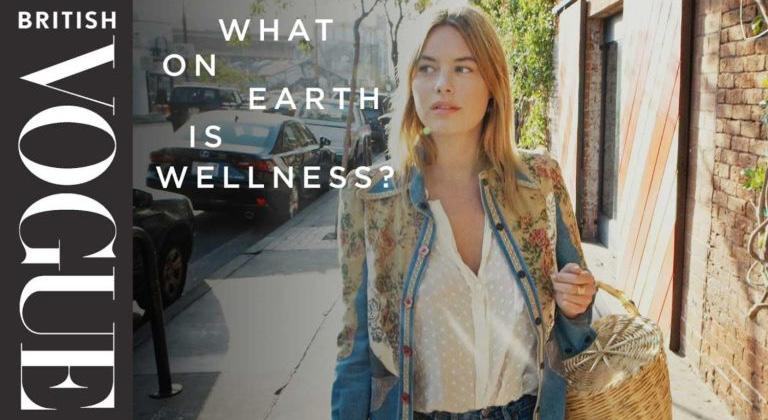 OLIVIA CHIAPPELLI Arts Reporter
OLIVIA CHIAPPELLI Arts Reporter
Upon hearing that our first issue back after break would be health and wellness themed, I only had one thing on my mind: British Vogue’s 2016 documentary series “What on Earth is Wellness?” hosted by Camille Rowe.
The five part series has stuck with me ever since I watched it for the first time almost seven years ago and upon rewatching, I found the information shared is more relevant than ever. So, please join me on this nostalgic wellness journey.
Episode 1: “Camille Rowe’s Personal Wellness Journey”
The first episode perfectly sets the scene of a culture crazed by the ubiquitous word “wellness,” and aims to demystify and evaluate the current cultural blind enthusiasm for all things well.
Rowe first meets with Dr. John Travis, the founder of the world’s first wellness resource center, to learn more about the history of wellness and how the term emerged into the mainstream. In 1961, Halbert Dunn, known as the father of the “Wellness” movement, wrote the book “High Level Wellness” which promoted a new understanding of health as a positive thing rather than simply an absence of disease.
The book taught that wellness was achieved through a holistic approach including not only the mind, body and spirit, but also the environment and community. Dr. Travis summarizes all of his work with six words: The currency of wellness is connection.
Over time, however, the original “Wellness” movement that emerged in 1970’s California has turned into an industry through commercialization and medicalization, and is far from the idea of wellness that Dunn had in mind.
Episode 2: “Camille Rowe Explores Nutrition & Supplements”
The second episode opens to the all too familiar image of a person trying to “get well”: overspilling cabinets of supplements.
Dr. Molly Maloof, a personalized health practitioner and a pioneer in the field of scientific wellness, explains that many of the vitamins and ingredients in supplements come from foods, and that supplements can be replaced by those foods in a lot of ways. She recommends looking at food first and then utilizing supplements for specific problems that you are trying to deal with over a specific time period.
Rowe also meets with clinical psychologist Dr. Danyale McCurdy-McKinnon to discuss the point when being so obsessed with being healthy becomes unhealthy. McCurdy-McKinnon sheds light on orthorexia, an unhealthy focus on eating in a healthy way, and the dangers of food rules, obsessional thinking and words like “clean eating” when it comes to health.
Episode 3: “Camille Rowe Explores Psychology & Spirituality”
Episode three follows Rowe as she explores routes to personal well-being through two wildly different lenses. She first sits down with neuropsychologist Dr. Robert Bilder who explains that mindfulness meditation has been well associated with an increased sense of wellbeing. The practice can actually change the expression of DNA in our cells and alter our response to stress, ultimately quieting down the signals that make us feel bad.
On the other end of the spectrum, Rowe visits LA’s
My go-to bad day albums
D’JUANNA LESTER Arts Reporter
Over the Thanksgiving holiday, the Oakland men’s baLet’s face it, life can hit really hard sometimes. No matter how much we try to stop it, bad days are bound to happen. We can’t stop that.
Whether it is a bad day at school or fighting with friends–bad days can come out of nowhere and completely interfere with our emotions. I know that one thing I do when I’m having a bad day is listen to music.
Music is an art form that brings out emotions in not only the artist, but the listener as well. Listening to music has always been one of my favorite comforts, but there are specific songs and albums that I consider to be my go-tos.
My go-to bad day albums are the ones that I play on repeat when my day isn’t going the way that I want it to. By listening to these songs, I feel a little bit of comfort knowing that a three-minute song can perfectly capture how I’m feeling at that moment.

“5SOS5” - 5 Seconds of Summer
The singles alone make this album one that I always
want to listen to - let alone the entire album. As a huge 5SOS fan I listen to their albums frequently, but 5S0S5 is one of my favorite albums, especially when I’m having a bad day. Tracks like “TEARS!”, “Emotions”, “Bad Omens” and “You Don’t Go To Parties” are my go-to sad songs when I’m in the middle of an off day.
These songs in particular are ones that I relate to, especially when I’m sad or anxious about something. Then there are the more upbeat songs from the rest of the album that raise my spirits a little bit. The entire album is vocal, lyrical, and instrumental genius.
“Midnights” - Taylor Swift
Midnights is an album that contains a wide range of tracks dealing with different issues. This album feels like a mix of my favorite Taylor albumsReputation and 1989, so of course I’m going to use this album to cheer myself up.
“Anti-Hero” and “You’re On Your Own, Kid” are very relatable songs while “Karma” and “Bejeweled” are songs that make me feel better after a hard day. Listening to this album makes me feel calm. It’s a soothing piece of art that draws out plenty of emotions.
crystal emporium Spellbound Sky where she explores the power of crystals on wellbeing and comes to the conclusion that “regardless of objective science, simply believing in something and acting accordingly can have a profound effect.”
Episode 4: “Camille Rowe Explores Meditation & Mindfulness”
In episode four, Rowe meets with Andy Puddicombe, the founder of Headspace, who explains the difference between mindfulness and meditation. Mindfulness is being present in the moment, while meditation is an exercise to learn and practice the process of being more mindful and aware.
Puddicombe also shares the useful tip of “coupling” when trying to create a habit of meditation. A routine of a shower every morning can easily become a routine of a shower and meditation every morning, which is not time specific and therefore focuses on quality over quantity.
Rowe also visits nutrition-savvy community enterprise LA Kitchen where she explores the oftenoverlooked connection between wellness and the health of our community.
Episode 5: “Camille Rowe Explores Fitness & Movement”
The fifth and final episode follows Rowe to a twohour dance class with 5Rhythms, a moving meditation practice founded by Gabrielle Roth which is based around waves of energy, movement, and music. The practice reveals the healing power of dance as not a spectator sport, but also a form of therapy.
While we could not see inside the dance class, the emotional vulnerability Rowe shows after the session is powerfully captivating and has stuck with me since I first watched this series.
Freeform barefoot dancing may not be for everyone, so Rowe goes hiking with Mark Hunter, founder of the free-of-charge Cobrasnake Fitness and explores how cardio can work wonders for the body and mind.
And finally, almost every specialist that Rowe met with stressed the importance of this wellness practice: being kinder to yourself.
“Sounds
This album is the epitome of “being in your feelings.” There’s no way to listen to this album without it provoking some kind of emotion - most of the time sadness. A dark album that explores so many themes, this is a definite go-to album.
“Jet Black Heart” will always be one of their best songs of all time. “Airplanes” and “Outer Space/ Carry On” are so sad and so good. No matter how many times I listen to this album, I always feel something. I wish I could go back and listen to it for the first time again.
PHOTO COURTESY OF BRITISH VOGUE ON YOUTUBE
Good Feels Good” - 5 Seconds of Summer
ARTS JANUARY 11, 2023 | 13
PHOTO COURTESY OF THE OAKLAND POST
Bills safety Damar Hamlin recovering well after suffering cardiac arrest
BROCK HEILIG Sports Editor
The football world was turned upside down on Monday night when Buffalo Bills safety Damar Hamlin collapsed on the field during a football game between the Bills and Cincinnati Bengals.

The 11-4 Bengals were hosting the 12-3 Bills in a game that was set to have vast playoff implications. Both teams were vying for the No. 1 seed in the AFC, and the winner of Monday night’s game would be in great position to secure it.
The Bills had won their previous six games, and the Bengals had won their previous seven games, making it the most anticipated game of the week, or perhaps the season.
Suddenly, none of it mattered.
In the first quarter, Bills safety Damar Hamlin made a routine tackle of Bengals wide receiver Tee Higgins. After making the tackle, Hamlin stood up and then collapsed, falling back on the ground.
Team trainers and medical staff rushed onto the field to help Hamlin, who was obviously in critical condition. He was eventually helped into an ambulance and later transported to a nearby hospital in Cincinnati.
The game was postponed, and fans left the stadium. However, football wasn’t on the mind of a single fan that night. Hamlin was.
The Bills safety is currently progressing well,
according to doctors. He is breathing on his own, and has communicated with his teammates via FaceTime.
Hamlin’s doctors met with the media earlier in the week.
“We would like to share that there has been substantial improvement over the past 24 hours,” said the doctors. “As of this morning, he is beginning to awaken and it appears that his neurological condition and function is intact.”
The 24-year-old had his breathing tube removed overnight between Thursday and Friday, and even posted on Instagram on Saturday, marking his first form of public communication since the incident.
“When you put real love out into the world it comes back to you 3x’s as much,” Hamlin wrote in his post. “The Love has been overwhelming, but I’m thankful for every single person that prayed for me and reached out.
On Thursday night, the NFL announced that the week 17 game between the Bills and Bengals would not be resumed, and that it would be deemed a ‘no contest.’
With the football world returning back to nearnormal, the NFL is scrambling to find a solution to its problem. For the first time since 1935, not all NFL teams will have played the same number of regularseason games, making for a playoff disaster, both seeding wise and home field advantage wise.
The game of football has been played for
PHOTO COURTESY OF KAREEM ELGAZZAR
more than a century, and this is, perhaps, one of the worst injuries in the sport’s history. It’s important to realize that, in the end, football players are humans, too.
Although it may not seem like it, they have emotions, and they have things that they go through, and when something tragic happens like it did on Monday night, we see the raw emotion of players that a lot of fans and people idolize.
Football is a dangerous sport, and although an instance such as Hamlin’s is likely to be a one-ina-million, it’s still a possibility, and a scary one.
Ways to satisfy social wellness around campus
PAYTON BUCKI Campus Reporter
As we begin the winter semester with frigid weather on the horizon, students may feel snowed under in terms of social engagement. When exhibiting this “buried” mindset, it is important to remember that social wellness is key to your overall health as a college student.
Fortunately, Oakland University provides students with a wide array of opportunities to get involved on campus. Student organizations, club sports, intramural sports leagues, and Student Program Board (SPB) events are just a few ways individuals can form friendships with others on campus.
The Office for Student Involvement (OSI) at Oakland University offers over 300 student organizations, each of which provides a social group for students that share a common interest. Due to

the wide array of options available, OU students are sure to find a club that fits their passions.
“I joined the Ecology Club at OU because I love attending nature related events like hikes. It’s also a good place to meet students who are in a similar major as me and share the same interests,” Oakland University sophomore Nicholas Skinner said.
Students can learn more about the student organizations offered at OU by visiting the GrizzOrgs website. This site also allows individuals to join groups they are interested in, simply by the click of a button.
GrizzOrgs is a useful tool, as it also provides a university-wide event calendar. This function allows students to easily view upcoming events for all campus organizations.
For active individuals that miss the community of organized sport teams, the OU Recreation and Well-Being Center (OU RecWell) offers a variety of Club Sports and Rec Well Sports opportunities. The two options require different levels of commitment, which makes it possible for even the busiest of college students to participate.
Over 30 student-run club sports teams are available to OU students, offering participants the opportunity to compete against other collegiate club athletes. These clubs often host organized practices for members, whilst hosting or traveling to competitions throughout the year.
“Our department mission is to offer programs, services and facilities that foster student development, create a connection to Oakland University and motivate our community toward a life-long commitment of well-being,” the University Recreation and Well-Being’s webpage states.
Rec Well Sports are perfect for students seeking a more casually competitive experience. RecWell offers many sports, including but not limited to, basketball, indoor hockey, flag football and indoor soccer.
Throughout the year, intramural athletic events are hosted within the OU Recreation Center. Although Rec Well Sports are competitive, they are designed to allow athletes of all skill levels to have fun while exhibiting good sportsmanship.
Rec Well Sports events are typically held later at night to make the leagues more accessible to those that have classes during the daytime. Thus, Rec Well Sports pose a good option for students that want to stay active, but are not able to commit to a Club Sport. Interested individuals can view and join Rec Well Sports and Club Sports through the RecWell portal.
Another way students can manage their social wellness is by attending campus events organized by SPB. SPB hosts unique programs for OU students throughout the year, giving individuals the opportunity to engage in fun activities in enjoyable, inclusive social settings.
The student-led group encourages participation by offering an “activity passport” program to students. Essentially, students gain stamps by attending SPB Hump Days, activities, and events for the chance to win prizes.
Social wellness is an important aspect in the overall well-being of college students. In order to manage this aspect of their health, Oakland University students should consider engaging in student organizations, Club Sports, Rec Well Sports, and SPB events on campus.
SPORTS 14 | JANUARY 11, 2023
PHOTO BY MAGGIE WILLARD
Self care tips for college students
OLIVIA CHIAPPELLI Arts Reporter
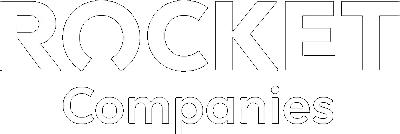
The irony is not lost on me that one flip of a page or scroll of a screen would reveal that I also wrote an article this week about how the commercialization of the wellness industry has caused us to lose sight of the actual movement, and now I am giving you self care recommendations. I am a victim of society.
However, in this college self care guide I will try my best to not appeal to the commercialization of wellness, but rather focus on practices you can utilize on your journey of being well. (I will also recommend products though because that is also just fun.)
1. Meditation
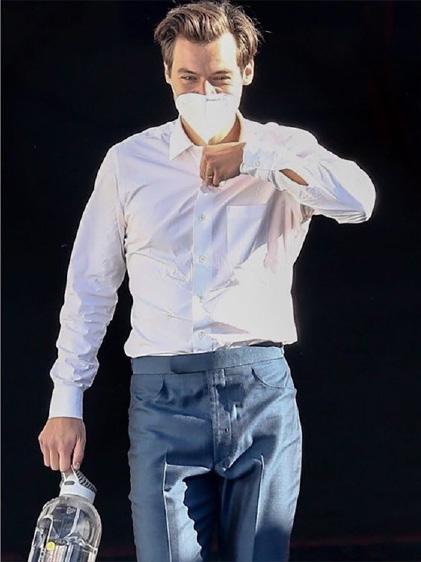
Meditation is everywhere right now. It feels like on every self-help guide meditation is one of the first things mentioned, yet the practice can still feel daunting or intimidating as a concept, especially for college students with already packed schedules and little time for sitting still.
For those unfamiliar, the steps to meditation are as follows: The first step is to find a place to sit that feels calm and quiet. The second step is to set a time limit for your meditation, five to ten minutes is a good place to start. The third step is to find a comfortable and stable position that you can stay in for the duration of your meditation.
The fourth step is to follow your breath as it goes in and out. The fifth step is to notice when your mind has wandered. At some point, especially if you are a beginner, your focus will shift from your breath so be prepared to have to intentionally return
your attention to your breathing.
This leads to the sixth step of being kind to your wandering mind. While often overlooked, this step is very important as you should not allow yourself to obsess over your intrusive thoughts, but rather just simply return your attention to your breath without judgment. The final step is to close your meditation with kindness while taking time to notice the sounds, feelings, thoughts and emotions around you.
Another tip for getting started with meditation as a college student is to practice coupling, where you pair the practice of meditation with something that is already in your daily routine. For example, if you know that you have a cup of tea every morning, make that time devoted to a cup of tea and a few minutes of meditation, that way making time for meditating can feel like less of a stressful inconvenience.
2. Mindful eating
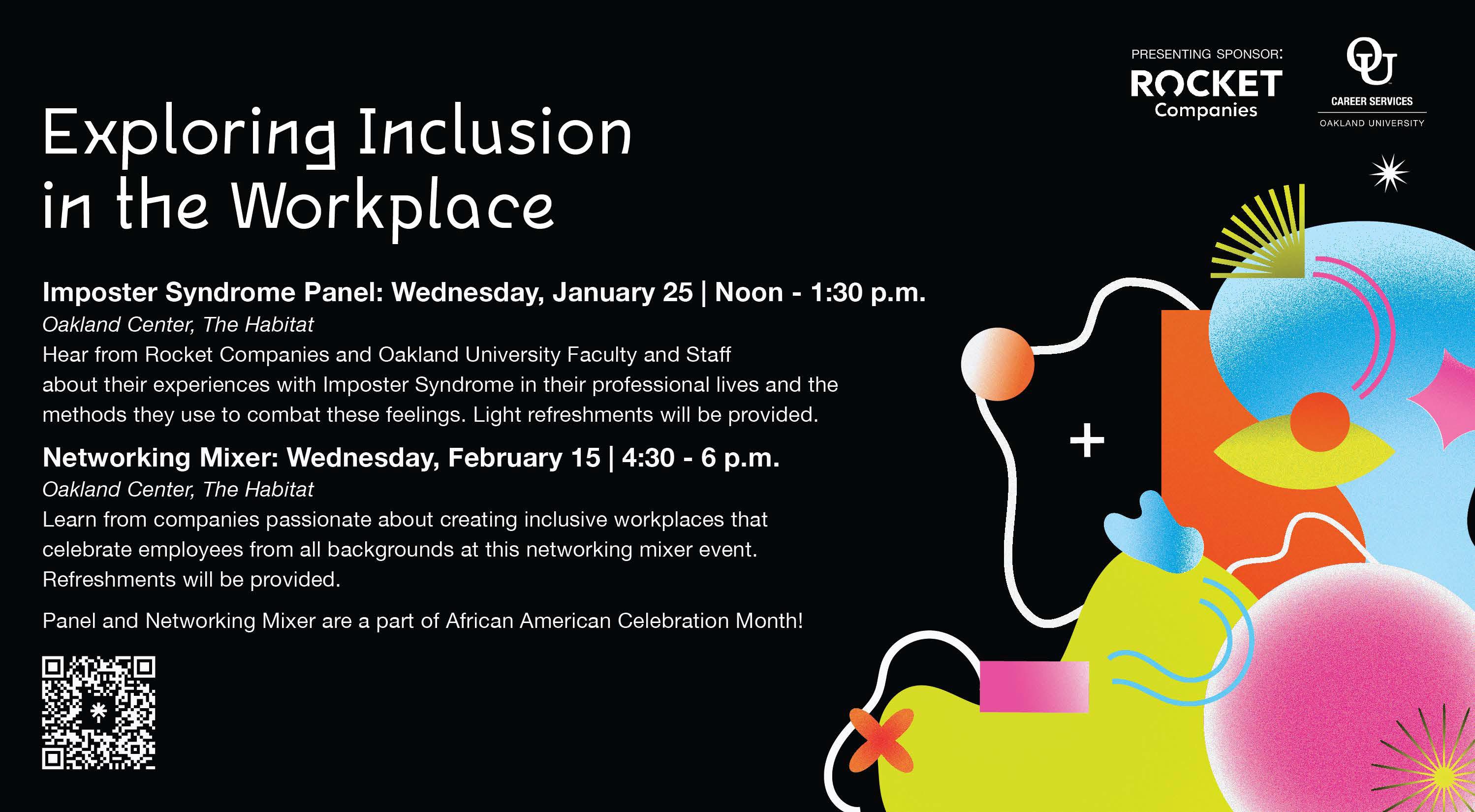
Another practice that you can employ as a college student to help promote your personal health and wellness is mindful eating. Mindful eating involves eating slowly and without distraction, like a phone or TV show. It is also about engaging your senses by noticing the colors, smells, textures and flavors of your food, as well as noticing the effects food has on your feelings and body.
Mindful eating helps you to distinguish between physical and emotional hunger, and also teaches you how to cope with the guilt and anxiety that often surround the idea of food by allowing you to appreciate your food as an intentional act rather than a mindless automatic one.
I have personally started to employ mindful eating into my daily life and have found that I

enjoy and appreciate my meals way more now that I have intentionally created a peaceful and calm experience to look forward to every day.
3. That trendy water bottle from Amazon with the encouraging quotes
Finally, I could not resist recommending at least one self care themed product when making this list and the chosen item is that trendy water bottle from Amazon with the encouraging quotes. I once saw Harry Styles using this giant water jug, and that seems pretty “well” to me.
PHOTO BY TWITTER
OPINION JANUARY 11, 2022 | 15
Harry Styles pictured toting around a giant water bottle — a wellness essential.
PRESENTING SPONSOR:

JANUARY 11, 2023 | 16






 PHOTO BY CHRIS ESTRADA
PHOTO BY CHRIS ESTRADA












 GABRIELLE ABDELMESSIH Editor-in-Chief
GABRIELLE ABDELMESSIH Editor-in-Chief
 OLIVIA CHIAPPELLI Arts Reporter
OLIVIA CHIAPPELLI Arts Reporter







